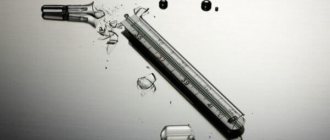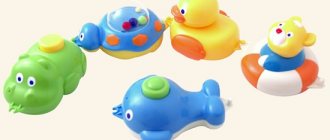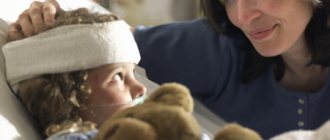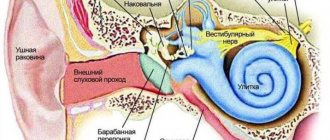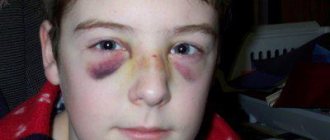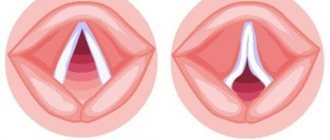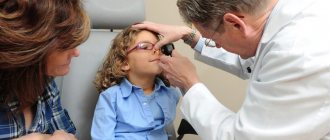Children are little explorers, constantly exploring, experiencing and “tasting” this world. In the process of constant search, many pleasant and not so pleasant events can happen. One of the most dangerous events is when a foreign object enters a child’s body through the throat, ear or nose. The most dangerous way for objects to enter the body is the throat. We’ll talk about diagnostic methods, first aid and removing foreign objects from the baby’s body in today’s article.
- What to do if a child swallows a foreign object
- What is the danger of having a needle or other sharp object in the body?
How to tell if a child has swallowed a foreign object
Most children begin to crawl at 7-8 months; from this period it is necessary to begin monitoring the baby’s location for the presence of small objects, carefully monitoring the integrity of toys, checking the quality of fastening and protecting batteries, etc.
Statistically, the most dangerous period in a child’s life is between 1 and 3 years of age. The baby already knows how to move quickly, but his knowledge of the world is not yet enough, and the instinct of self-preservation is poorly developed. The appearance of the first words in speech and walking independently can relax parents, creating the illusion of independence for their son or daughter. There is no need to succumb to this illusion!
It is recommended to supervise the child as much as possible, remove unnecessary objects, creating a safe environment. This recommendation is important not only for children from 7 months to 3 years, but also for older children, up to 7 years. Toddler and preschool age is characterized by low attentiveness on the part of boys and girls, who, without knowing it, can create a dangerous situation. The role of the parent is to try to predict possible scenarios.
Of course, it will not be possible to completely predict all situations, so you need to be prepared for negative scenarios. Let's look at what can happen if a child swallows a foreign object to quickly navigate the specifics of first aid.
Qualified help
If a child has swallowed a plastic part of a toy, which can pose a real danger to him, he must be hospitalized. In the hospital, using an X-ray or ultrasound examination, a specialist will identify the place where the part is “stuck”. If a small object gets into the stomach, it can be eliminated after research. If a foreign part gets into the bronchi, the doctor will work under anesthesia, since his manipulations can cause pain in the baby. In order to prevent infection of the bronchi and lungs, the doctor may additionally prescribe a course of antibiotics.
The exact location of a foreign object in the body can only be determined through research.
Foreign object in the child's body. Possible scenarios
If a foreign object enters the body through the mouth, 2 scenarios are possible:
- the object enters the larynx and gets stuck in the respiratory tract;
- the object passes through the pharynx into the stomach.
You need to know that each of these scenarios has its own procedure for providing assistance.
Entry into the respiratory tract
What happened: the baby was playing with an object and put it in his mouth.
While laughing, talking, jumping, a foreign body slipped into the respiratory tract and now disrupts the flow of air. Signs of what happened appear immediately. The degree of their manifestation depends on the size and shape of the object.
Signs of an object entering the respiratory tract:
- suffocation, oxygen deficiency;
- severe, spasmodic cough;
- the child holds his throat and complains of pain;
- the baby’s voice is hoarse or completely lost;
- labored breathing;
- a specific clapping sound is heard in the tracheal area when a child cries or screams;
- shortness of breath, wheezing, weakened breathing;
- symptoms of bronchitis and pneumonia rapidly appear;
- face turns blue.
Getting a foreign object into the respiratory system is the most dangerous option, developing very quickly. In such a situation, you need to act very quickly and clearly.
What to do if an object gets stuck in the respiratory tract. The child is suffocating
- Do not panic.
- Call an ambulance immediately. It is better if a second adult does this while you carry out urgent measures. On the phone, clearly say that the child has an object stuck in the respiratory tract, be sure to give the exact address, the age of the baby;
Infant:
- you need to lie on your knees face down so that the upper part of the body is slightly lowered;
- put your finger in your mouth, opening it;
- With the other hand, pat your back several times in the area of the shoulder blades. Do this carefully so as not to damage your spine!;
- You can also place the baby with his back on his knees, at a certain angle and make a few pushes in the area below the nipples.
We must always remember that the purpose of these actions is to make breathing easier. If the baby is breathing normally, then there is no need to do this! Patting can cause the object to dislodge and block the airways.
Child over 1 year:
- come up from behind and grab, pressing on the stomach in the area above the navel 4-5 times with a break of a few seconds;
- repeat the appointment several times until the doctors arrive.
If the child has cyanosis, artificial ventilation should not be performed. The subject can go even deeper.
Then the children receive medical care in a hospital setting. Endoscopy of the respiratory system must be performed under anesthesia, after which, if necessary, antibiotic therapy is prescribed to prevent bronchitis and pneumonia.
The object entered the gastrointestinal tract
What happened: The baby was playing with a small object, put it in his mouth and accidentally or intentionally swallowed it. Children under 3 years old may not pay attention to what happened. Older kids may be scared and not immediately tell adults so as not to be scolded.
The main signs of a foreign body in the gastrointestinal tract:
- cry. Most children's first reaction to swallowing a foreign body is crying. Children under 3 years old in most cases cry from fear, older children cry from understanding what happened;
- vomiting or nausea if an object gets stuck in the esophagus;
- belching , when an object is in the stomach;
- loss of appetite, complete refusal to eat;
- increased salivation;
- an increase in temperature within 37-38 degrees Celsius without visible symptoms of the disease;
- changes in the child's behavior. The baby becomes unusually quiet and obedient (this is especially noticeable in children over 3 years old);
- change in stool: with mucus , with blood, darkened
- sometimes loss of consciousness.
A child may have several or one of the listed signs.
If a small round or smooth object is swallowed, such signs may not be observed. This is the most favorable option. Adults can find out about the presence of a foreign object in the baby’s body by chance by noticing it in the feces.
But if a child develops the indicated symptoms, measures must be taken.
What to do if a child swallows a foreign object
- Don't panic.
- Call a doctor or go to the nearest emergency room.
- When the first signs of suffocation appear, while waiting for an ambulance, you need to sit down, bend your leg at the knee and place the child face down on it, while tapping your fingers on the back between the shoulder blades.
- While waiting for the ambulance, try to calm the child down, ask him what kind of object he swallowed (if the baby can talk).
What not to do
- Do not give food in the hope that the food will push the object into the stomach. This can cause suffocation and make it difficult for specialists to remove the object;
- Do not try to get the item yourself, so as not to aggravate or harm the child. Do not use tweezers, forceps or other tools, as this may not only prevent you from reaching the item, but also cause additional harm;
- Do not try to return the object in the opposite direction: do not hit it on the back, do not turn it upside down, do not shake it. You can only make the situation worse, and in some cases, cause additional injuries.
What to do if a child swallows a battery
If you find that your baby has swallowed a battery, do not panic and immediately call an ambulance or go to the nearest emergency hospital.
Do not attempt to remove the battery yourself. Any manipulations should be carried out only after an x-ray. The doctor will see where the object is and, based on this, will take the most appropriate extraction option.
If you are sure that your baby has swallowed a battery, then you need to get to the hospital as soon as possible. DON'T POSTPONE TILL TOMORROW. Every minute that a battery is in a child's body can lead to a reaction that can cause irreparable harm.
After the x-ray, it will be clear what needs to be done next:
- the most favorable option is that the battery is not stuck on the way to the intestines, but is moving towards the exit. In this case, it is possible for a doctor to prescribe laxatives and wait for the battery to come out naturally, under the strict supervision of specialists;
- If a battery gets stuck in any part of the gastrointestinal tract, the doctor will be forced to urgently remove it in the most productive way.
Why is it dangerous for a battery to be in a child's body?
While in the gastrointestinal tract, any type of battery begins to oxidize and complex chemical reactions occur. As a result, irritation begins at the point of contact of the battery with the body, and a burn occurs to the mucous membrane. In the most unfavorable cases, death or the need to replace the damaged organ or part thereof is possible.
What to do if a child swallows a magnet
If a child swallows a magnet, do not panic and immediately call an ambulance or go to the nearest ambulance station.
The magnet itself, swallowed in one copy, carries no more danger than a wooden or plastic object. In the worst case scenario, 1 magnet can close the intestinal lumen or cause the gastrointestinal tract to stop functioning. In one instance, the magnet does not interact with organs and tissues; often it is only necessary to prescribe laxatives and monitor the doctor’s natural exit from the body.
Swallowed magnetic balls
Getting 2 or more magnets into the body is dangerous, especially if this happens at different intervals. Once in the gastrointestinal tract, the magnets are close to each other and begin to interact.
Depending on the location of each of the magnets during attraction, the edges of the intestine may be pulled together, large indigestible adhesions may form, completely closing the lumen of the stomach or intestines.
In the most unfavorable case, interaction can occur when the magnets are in different parts of the gastrointestinal tract. Obeying the law of nature, magnets will be attracted to each other, pinching the delicate tissues of the child’s body, injuring them, causing irritation, ruptures, necrosis (death) with prolonged exposure.
If your baby swallows 1 or more magnets, go to the emergency room immediately. Subsequent actions can only be determined after an x-ray.
What to do if a child swallows a needle or object with sharp edges
If a child swallows a needle, an object with sharp edges, or a bone is stuck in the throat, do not panic and immediately call an ambulance or go to the nearest ambulance station.
While waiting for an ambulance or on the way to the hospital, follow these recommendations:
- calm down your son or daughter. Screaming or loud crying can contribute to injury to the surrounding walls of the gastrointestinal tract from the sharp edges of a swallowed object;
- Do not allow your child to bend or bend over. When bending over, the sharp edges of a foreign object can further injure the child’s internal organs;
- do not shake or turn the baby over. The upper half of the body should be as motionless as possible;
- do not ask your son or daughter to cough in the hope that a foreign object will pop out;
- do not give laxatives or antiemetics.
Most often, if a needle or other object with sharp edges has entered the stomach, it will come out naturally, but this can only be confirmed during an x-ray examination. It is also necessary to confirm the absence of wounds and cuts along the path of the foreign body.
If a needle or other sharp object gets stuck in the soft tissues of the throat or trachea, endoscopy (removal with a special tool) is necessary, which should be carried out by a specialist doctor.
What is the danger of having a needle or other sharp object in the body?
When a sharp object remains in the child’s body for a long time, chemical processes of corrosion, oxidation, and decomposition of the foreign body begin. At the point where a needle or other object comes into contact with the mucous membrane of the gastrointestinal tract, inflammation begins and an abscess forms. The formation of such a focus of inflammation requires complex and lengthy therapy.
What to do if your child swallows something small
Small, round, streamlined objects are more likely to come out naturally. It is necessary to watch the baby. If he is calm, his behavior has not changed, his appetite is normal, the tactics will be wait-and-see, there is no need to worry. You can feed your baby foods rich in fiber.
You should never do cleansing enemas or give laxatives. This can injure the walls and contribute to intestinal obstruction. “Noli nocere”, as they say in Latin (“Do no harm”).
If the child’s behavior or condition begins to change, or signs of a foreign body appear in the body, call an ambulance or go to the nearest ambulance station.
What to do if your child swallows medicine or pills
- Do not panic;
- To provoke vomiting: place your fingers in the baby’s mouth and press on the root of the tongue;
- Call an ambulance or go to the nearest emergency department;
- Take with you the instructions for the swallowed medicine or the box of it, the doctor will need this to determine the need for complex detoxification therapy.
In most cases, if a child has swallowed a medicine that does not cause toxic damage to the body, he will be prescribed treatment with activated carbon or other sorbents, and may also need temporary fasting.
The child swallowed mercury pellets or drank/ate household chemicals
Ingestion of objects or chemical compounds into the body is a danger that requires immediate medical attention. Mercury and household chemicals pose a particular danger to children's bodies. They affect the nervous system, lungs, kidneys, stomach, etc. If a child swallows mercury balls or drinks/ate household chemicals:
- Do not panic;
- Induce vomiting in the child: put 2 fingers into the baby’s mouth and press on the root of the tongue;
- Call an ambulance. When calling, be sure to tell them what your child drank or ate and give your exact address.
Surgical solution to the problem
After passing the examination, the surgeon decides on the further course of treatment. It all depends on the location of the dangerous object. The patient may be offered the following manipulations:
- Placing a person in a hospital . A small piece of glass may pass out of the body on its own. Then the doctors leave the patient in the hospital, prescribing him a laxative. Mandatory observation involves monitoring of ultrasound diagnostics;
- Endoscopic surgery . The most gentle method is used everywhere, as it is characterized by 99% efficiency in removing foreign bodies and collects positive reviews. The only time when endoscopy is ineffective is when the glass is located below the duodenum. The operation is performed under local anesthesia or without it, with the exception of small children. The doctor inserts the device through the throat and, under camera control, hooks and pulls out the glass. Sometimes, with the help of an endoscope, it is possible to push the object through for further natural removal;
- Laparoscopy . If the location of the glass does not allow the use of endoscopy and waiting for an independent conclusion is dangerous to health, the surgeon decides on abdominal surgery or laparoscopy. The significant difference between the second method and the first is that the doctor makes small punctures in the abdominal cavity, which heal faster and do not have global consequences, unlike an abdominal incision.
Whatever option the surgeon chooses, being in the clinic is necessary for quality treatment.
What to do if a child pushes a foreign object into the ear, nose, or butt
Children's curiosity knows no bounds. Kids constantly explore not only the world around them, but also their own bodies. Quite often, boys and girls from 1 to 3 years old not only put objects in their mouths, but also try to push them into other openings on the body. What to do if this situation happens to your baby? Provide immediate assistance:
- Do not panic;
- Do not attempt to remove the item yourself. Even if it seems that the object is very close and you can easily reach it yourself, you should not take the risk;
- Call an ambulance or go to the nearest emergency hospital;
- Try to calm the child down.
A foreign body from the ear or nose must be removed by a specialist using special tools. After the passage is released, it is imperative to check the nose or ear for damage and, if necessary, prescribe treatment.
Removing objects from the anus is usually done naturally. The baby is given a laxative and waits for the intestines to clear. If the object in the colon is sharp, it can be removed using special tools.
How to avoid foreign bodies entering a child’s body. Safety regulations
It is easier to prevent any unwanted situation than to deal with the consequences. We have prepared a number of recommendations for you to improve the safety of your son or daughter.
- From the child’s first attempts to move (crawl, walk, run), try to keep him in your field of attention, watch what he plays with, what he puts in his mouth;
- Remove all potentially dangerous objects from the baby’s access: small, sharp, fragile, household chemicals, medicines, thermometers;
- Before offering a toy to your child, check its integrity. Don't let them play with cracked or broken objects. Offer age-appropriate options;
- If the toy has a battery, be sure to check whether it is hidden well and whether the hole for the battery is secured with an additional bolt;
- Don't let them play with magnets, especially small ones. If your baby plays with a fairly large magnet from your refrigerator, be sure to check that the magnetic base is well attached. The best option is if the magnet is on a magnetic tape evenly distributed over the entire area;
- When using educational games with small objects, do not leave the child alone with beads and cereals. Every movement of the baby should be under your control;
- Try not to make people laugh or chat with your child while eating. From a very early age, teach people to eat in a calm environment;
- Don't let your baby jump or run around with his mouth full or with an object clenched between his teeth or lips.
By following these rules, you will protect your baby from carelessly swallowing foreign objects and substances. In order not to endlessly say “No”, not to worry and not to look for possible signs of swallowing foreign objects, create conditions in which the baby can satisfy his curiosity without threatening his life.
If you liked the article, please share a link to it
